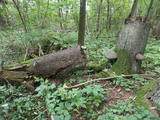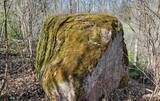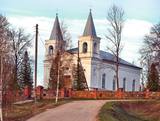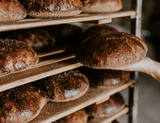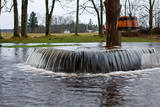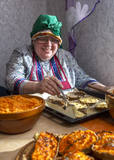| Nr | Name | Beschreibung |
|---|---|---|
|
Dabas liegums veidots ainaviskā Kāla ezera trīs salu (Tolkas, Lielā Vestienas un Vistu sala) un to mežu biotopu aizsardzībai. Diemžēl, salu apmeklētāji (makšķernieki?) aiz sevis ir atstājuši ne tikai nelabiekārtotas apmetņu un ugunskuru vietas, bet arī atkritumus. Tā kā salu vērtību spēs novērtēt tikai zinošs speciālists, ieteicams dabas liegumu vērot no skaistajiem un pauguriem klātajiem Kāla ezera ziemeļu un austrumu krastiem. Teritorija atrodas Vestienas aizsargājamo ainavu apvidū.
|
||
|
The farm uses ancient recipes from grandmothers to bake aromatic sourdough and rye bread on maple leaves, with the crunch crust being processed with flax oil. You can help to bake the bread and then taste and buy it. |
||
|
Also known as Lake Jēsis or Lake Iesis, this is the lake in Latvia which has the largest number of islands. Many literary sources and encyclopaedias in the 20th century claimed that there were 69 islands in the lake, but that was an exaggeration, because apparently the authors took sandbars overgrown with reeds and other plants to be islands. The true number is approximately two times lesser. The largest number of islands can be found in the north-eastern part of the lake. The largest one is Lielā Lāča (Big Bear) Island (45 ha). A farm was on the island at one time. The islands and the oak trees that are on the shores of the lake – the Piļoru and Pahatnīku stands of trees – are in a restricted environmental reserve. |
||
|
SIA "Limbažu Tīne" ir vilnas pārstrādes uzņēmums ar senām mājas tekstila tradīcijām, kas dibināts jau 1914. gadā. Šobrīd uzņēmumā tiek ražota vilnas dzija, austi augstvērtīgi vilnas un linu audumi, segas, parklāji, pledi, galdauti, dvieļi, lakati un citi tekstilizstrādājumi. Limbažu Tīne ražo etnogrāfiskos audumos pēc autentiskajām Baltijas reģiona kultūrvēsturiskā mantojuma paraugiem. |
||
|
Viens no diviem nacionālā parka skatu torņiem, kas atrodas ~ 1,5 km ziemeļos no Ehijerva ezera (Ähijärv). Tornis ir veiksmīgi „nomaskēts” nelielā priežu pudurī, tādēļ tas „nebojā” izcilo dabas un kultūrainavu, kas paveras no tā skatu platformas. Pie autostāvlaukuma ir izveidota labiekārtota atpūtas vieta. |
||
|
Einer der schönsten Gärten in Nica, der besonders Herzblattlilien und Ahornen gewidmet ist. Die Kollektion der Herzblattlilien umfasst mehr als 130 Sorten, während die Zahl der Ahornarten auf 25 gestiegen ist. Am großen Teich kann man Fische füttern und sich an der Schönheit des Gartens erfreuen. Sowohl die Hausherren als auch die Gäste erfreuen sich an der besonderen Wertschätzung, die durch die Kennzeichnung als Preisträger bei Wettbewerben um den schönsten Hof sowohl im regionalen als auch nationalen Maßstab zeugt. |
||
|
Meklējams Ostas ielas promenādes malā, 100 m ziemeļaustrumos no Ventspils Livonijas ordeņa pils. Veltīts jaunlatviešu kustības aizsācējam, publicistam un politiķim, kā arī pirmās Latvijas jūrskolas dibinātājam. Uz soliņa sēdošais Krišjānis ar savu skatu „pavada” katru ostā ienākošo izejošo kuģi. |
||
|
The Boulder of Labvārži is located in the Northern side of Adamova Nature Park, in the SW of Lake
Vizulītis (Labvārži). It is located 0,70 km from the Labvārži or Laboržu House. The boulder is 5.9m long and
4,0 m wide.
|
||
|
Ein nettes Café, das sich im alten Volkshaus befindet. Darin werden einzigartiger Käse, Teigtaschen, Suppe aus Pfifferlingen, Bohnen und Graupen, vadsas, Getränk aus Mädesüß-Sirup zubereitet. |
||
|
Sts. Simon and Judas Roman Catholic Church of Dricāni was
built in 1859 on the top of the hill. There is the wooden altar of the Holy Spirit, decorated with woodcarvings, wooden statuettes and the icon of Simon and Jude.
|
||
|
Atpūtas centrā tiek piedāvāta iespēja atpūsties brīvā dabā kolektīviem vai individuāliem apmeklētājiem. Iespējams izmēģināt dažādus metamos ieročus (nažus, cirvjus u.c.), kā arī šaušanu ar dažāda veida lokiem, arbaletiem, pneimatiku u.c. |
||
|
Ein Platz eines alten und bedeutenden Handels- und Handwerkszentrum am linken Ufer des Stausees des Rigaer Wasserkraftwerkes, der sich über den Fluss auf 15 m erhöht. Man nimmt an, dass bei einem kleinen Bach – einer Mündung des Flusses Varžupīte nahe der Wallanlage von Daugava sich ein in den historischen Unterlagen erwähnter Hafen von Semgallen befand. Gemäß gefundenen alten Gegenständen kann man behaupten, dass die Wallburg und eine alte Stadt am Fuße der Wallburg bis zum Ende des 12. Jahrhunderts besiedelt waren, als die Bedeutung von Daugmale von der rasch wachsenden Stadt Riga verringert wurde. Der Fuße der Wallburg ist befestigt. |
||
|
Die Bäckerei von N. Bomis SIA „Lielezers" ist ein Unternehmen des Einzelinhabers Normunds Bomis, gegründet im Jahr 1991, 3 km von Limbaži entfernt. In der Bäckerei wird gesüßtes Roggenbrot von Hand gebacken, das gebrühte Mehr wird 24 Stunden in Backtrogen aus Espenholz mit Sauerteig reifen gelassen. Das gesüßte Roggenbrot ist im EU–Lebensmittelqualitätssystem als Produkt mit garantierten traditionellen Spezialitäten registriert. Das Brotbacken wird von den erfahrenen Bäckern Lāsma Bome und Valters Kanopa geleitet. |
||
|
Ein mit Wäldern bedecktes Gebiet, durch welches der Fluss Gauja fließt. Alte Flussärme, parkartige Eichenwiesen, Laubwälder und Schutzarte. Naturpfade. |
||
|
Ļoti skaists un ainavisks etnogrāfiskais ciems Balošas (Baluošas) ezera ziemeļu krastā, netālu no diviem iepriekš minētajiem ciemiem. Te apskatāmas interesantas un skaistas koka ēkas, kas celtas no guļbaļķiem, ar niedru vai lubiņu jumtiem un izrotātas ar dažāda veida dekoratīvajiem elementiem. Pirmo reizi rakstos Šumini minēti 1784. g. Savu vārdu ciems ieguva no kādreiz dzīvojošas ģimenes uzvārda. Kā interesantākā ir jāpiemin sena klēts. |
||
|
Der Ort Tuhala ist schon seit 3000 besiedelt. Im Gebiet befinden sich 11 prähistorische Siedlungsreste, 30 Opfersteine, 3 Hügelgräbe, 4 Heiden u.a. Im Landschaftsschutzgebiet Tuhala befindet sich der unikale Hexenbrunnen, aus dem beim Hochwasser bis 100 l Wasser herauskocht, und fünf Estlands mächtigste Energiesäulen. |
||
|
The craftsman offers useful household products such as terrines, pots to make pickles, dishes of sugar and salt, bowls, etc. You can learn about pottery traditions and watch as the kiln is opened. |
||
|
Die Bezeichnung der Region Žemaitija bedeutet wörtlich «das niedrige Land«. Auf Ihrer Reise werden Sie sowohl traditionelle als auch ungewöhnliche Bauernhöfe besuchen. Die Reise bietet Ihnen auch die Möglichkeit, alte žemaitische Traditionen des Gartenbaus kennenzulernen und Tee und Gewürze aus einer biologisch-dynamischen Landwirtschaft zu genießen. Die Landwirtin ist immer bereit, eine kulinarische Meisterklasse im Zubereiten traditioneller žemaitischer Gerichte zu geben. An der nächsten Station der Reise werden Sie in die Geheimnisse der Heilkräuter eintauchen. Ein eindrucksvolles Objekt der Militärgeschichte ist das Museum des Kalten Krieges im Territorium des ehemaligen Raketenstützpunktes. Dann folgt ein Besuch des Energie-Labyrinths, wo Sie vollkommene Ruhe erleben können und vieles über den Einfluss verschiedener geometrischer Formen auf das menschliche Wohlbefinden erfahren werden. Die Reise führt Sie weiter zu einem traditionellen Bauernhof. Dort gibt es reichlich regionale Speisen zu essen, regionale Getränke zu trinken und Lieder zu singen. Auf dem Weg werden Sie auch die Stadt Telšiai besichtigen, die als informelle Hauptstadt der Region Žemaitija gilt. Zum Abschluss der Reise werden Sie einen Bauernhof besuchen, wo traditionelle Šakotas (Baumkuchen) am Lagerfeuer gebacken werden und Sie in eine echte litauische Sauna gehen können |
||
|
Das Dorf befindet sich 7km nördlich des Zentrums von Vecpiebalga. Hier kann man für die Gegend typische Landhöfe und Handwerkerhäuser des 19.Jh. mit Arbeitsgeräten und Gegenständen des täglichen Lebens besichtigen, auch eine kürzlich erneuerte Windmühle. Im Dorf leben auch heute noch einige Bewohner. Es empfiehlt sich, das Museum mit einem ortskundigen Führer zu besuchen. |
||
|
A true Latvian landlady, Skaidrīte Nagliņa, will welcome you to this farm and show you how to bake traditional bread. Old recipes and a bread oven heated by firewood will lead to beloved and tasty carrot buns, fresh sourdough bread and “pizza” ὰ la the Suiti. For groups up to 10 people. Please contact the farm in advance of your visit. |
||
